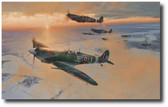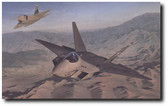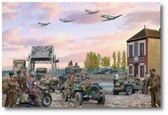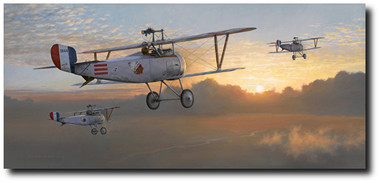 Loading... Please wait...
Loading... Please wait...- Home
- Aviation Art - By Artist
- Russell Smith
- By the Dawn's Early Light
Categories
By the Dawn's Early Light
Product Description
By the Dawn's Early Light by Russell Smith
Giclee prints on paper
Edition size of 250
Print size: 28" x 15.5 "
Image size: 24” x 11”
S/N by Artist
By the Dawn's Early Light is a tribute to the men and machines of the famed Lafayette Escadrille. Here we see three famous pilots from the escadrille - Lufbery, Thaw and Hill - on a morning patrol over the Western Front sometime during autumn of 1916.
The Lafayette Escadrille was formed in April of 1916, prior to the US entry into WW1. It had the unique distinction a French Sqaudron made up almost entirely of American Volunteers. The escadrille flew several different types of single seat fighters during its span and was officially known as N124 (during the period that they flew Nieuports) or SPA124 (during the period that they were assigned SPADs).
The machine that is perhaps most associated with the Escadrille was the Nieuport 17. The 17, an improvment on the earlier Nieuport 11 and 16 designs, carried a Vickers machine gun mounted to fire through the propeller arc and often carried a Lewis gun mounted on the top wing. The fabric surfaces of N17 were usually covered in an aluminum-based dope, giving the machine a silver appearance.
In the foreground we see Raoul Lufbery, the highest scoring and most well-known pilot of the Lafayette Escadrille. Lufbery is at the controls of Nieuport 17 N1844, a machine assigned to the group's Captain, Georges Thennault, but usually associated with Lufbery. A quiet man of mixed French and American decent, Lufbery took great care of his equipment. His plane was always the best in the squadron, as noted by fellow pilot Edward Hinkle, “Anyone would rather have a secondhand Lufbery machine than a new one anytime”.
In the lead, flying N1803 is Lt William Thaw. Thaw was one of the original founders of the Lafayette Escadrille and is credited with the idea of using the famous Seminole Indian head as the group's logo (see Mark of Distinction).
Finally, below and beyond Lufbery is Dudley Hill, flying N1950. Hill, the 12th man to voluteer for the escadrille was blind in one eye but never the less passed his physical exams by memorizing the eye chart. He was a well-liked pilot and managed to log more flying time than any other escadrille member.








